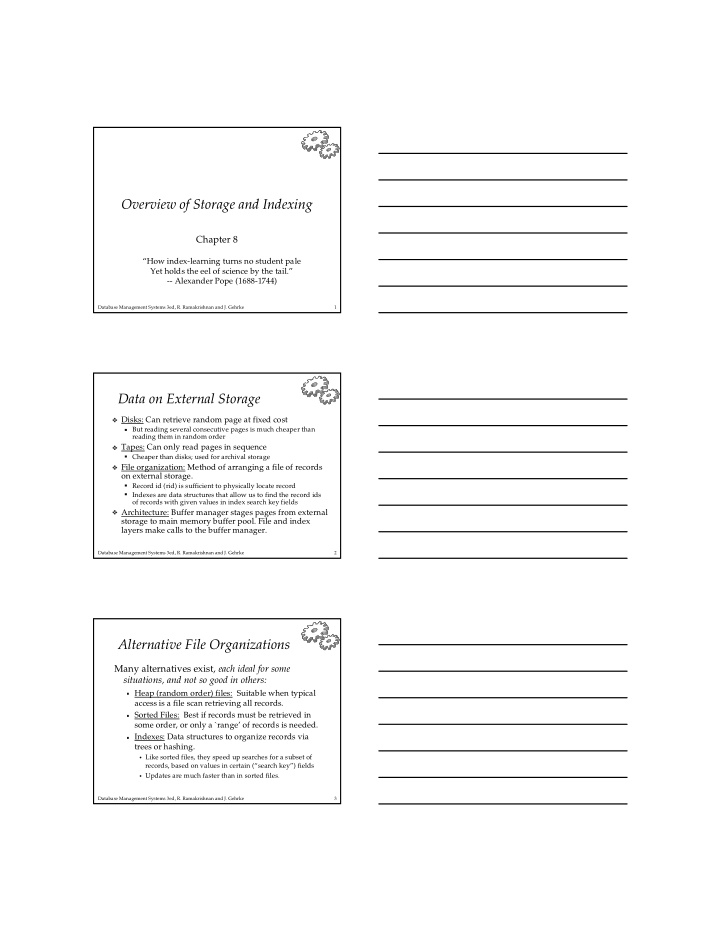



✁ ✁ ✂ ✂ ✂ � � ✁ ✁ � � Overview�of�Storage�and�Indexing Chapter�8 “How�index-learning�turns�no�student�pale Yet�holds�the�eel�of�science�by�the�tail.” -- Alexander�Pope�(1688-1744) Database�Management�Systems�3ed,�R.�Ramakrishnan�and�J.�Gehrke 1 Data�on�External�Storage Disks: Can�retrieve�random�page�at�fixed�cost But�reading�several�consecutive�pages�is�much�cheaper�than� reading�them�in�random�order Tapes: Can�only�read�pages�in�sequence Cheaper�than�disks;�used�for�archival�storage File�organization: Method�of�arranging�a�file�of�records� on�external�storage. Record�id�(rid) is�sufficient�to�physically�locate�record Indexes are�data�structures�that�allow�us�to�find�the�record�ids� of�records�with�given�values�in�index�search�key fields Architecture: Buffer�manager stages�pages�from�external� storage�to�main�memory�buffer�pool.�File�and�index� layers�make�calls�to�the�buffer�manager. Database�Management�Systems�3ed,�R.�Ramakrishnan�and�J.�Gehrke 2 Alternative�File�Organizations Many�alternatives�exist,� each�ideal�for�some� situations,�and�not�so�good�in�others: Heap�(random�order)�files: Suitable�when�typical� access�is�a�file�scan�retrieving�all�records. Sorted�Files: Best�if�records�must�be�retrieved�in� some�order,�or�only�a�`range’�of�records�is�needed. Indexes: Data�structures�to�organize�records�via� trees�or�hashing.�� • Like�sorted�files,�they�speed�up�searches�for�a�subset�of� records,�based�on�values�in�certain�(“search�key”)�fields • Updates�are�much�faster�than�in�sorted�files. Database�Management�Systems�3ed,�R.�Ramakrishnan�and�J.�Gehrke 3
✁ � � ✂ � ✁ ✁ ✁ � ✂ ✁ ✂ � ✂ ✂ Indexes An� index� on�a�file�speeds�up�selections�on�the� search�key�fields� for�the�index. Any�subset�of�the�fields�of�a�relation�can�be�the� search�key�for�an�index�on�the�relation. Search�key� is�not the�same�as� key (minimal�set�of� fields�that�uniquely�identify�a�record�in�a�relation). An�index�contains�a�collection�of� data�entries ,� and�supports�efficient�retrieval�of�all�data� entries� k*� with�a�given�key�value� k . Database�Management�Systems�3ed,�R.�Ramakrishnan�and�J.�Gehrke 4 Alternatives�for�Data�Entry� k*� in�Index Three�alternatives: Data�record�with�key�value k < k ,�rid�of�data�record�with�search�key�value k > < k ,�list�of�rids�of�data�records�with�search�key� k > Choice�of�alternative�for�data�entries�is� orthogonal�to�the�indexing�technique�used�to� locate�data�entries�with�a�given�key�value� k . Examples�of�indexing�techniques:�B+�trees,�hash- based�structures Typically,�index�contains�auxiliary�information�that� directs�searches�to�the�desired�data�entries Database�Management�Systems�3ed,�R.�Ramakrishnan�and�J.�Gehrke 5 Alternatives�for�Data�Entries�(Contd.) Alternative�1: If�this�is�used,�index�structure�is�a�file�organization� for�data�records�(instead�of�a�Heap�file�or�sorted� file). At�most�one�index�on�a�given�collection�of�data� records�can�use�Alternative�1.��(Otherwise,�data� records�are�duplicated,�leading�to�redundant� storage�and�potential�inconsistency.) If�data�records�are�very�large,��#�of�pages� containing�data�entries�is�high.��Implies�size�of� auxiliary�information�in�the�index�is�also�large,� typically.� Database�Management�Systems�3ed,�R.�Ramakrishnan�and�J.�Gehrke 6
✂ ✂ � ✂ � ✂ � ✂ ✂ ✂ ✂ � Alternatives�for�Data�Entries�(Contd.) Alternatives�2�and�3: Data�entries�typically�much�smaller�than�data� records.��So,�better�than�Alternative�1�with�large� data�records,�especially�if�search�keys�are�small.� (Portion�of�index�structure�used�to�direct�search,� which�depends�on�size�of�data�entries,�is�much� smaller�than�with�Alternative�1.) Alternative�3�more�compact�than�Alternative�2,�but� leads�to�variable�sized�data�entries�even�if�search� keys�are�of�fixed�length. Database�Management�Systems�3ed,�R.�Ramakrishnan�and�J.�Gehrke 7 Index�Classification Primary vs.� secondary :��If�search�key�contains� primary�key,�then�called�primary�index. Unique index:��Search�key�contains�a�candidate�key. Clustered vs. unclustered :��If�order�of�data�records� is�the�same�as,�or�`close�to’,�order�of�data�entries,� then�called�clustered�index. Alternative�1�implies�clustered;�in�practice,�clustered� also�implies�Alternative�1�(since�sorted�files�are�rare). A�file�can�be�clustered�on�at�most�one�search�key. Cost�of�retrieving�data�records�through�index�varies� greatly� based�on�whether�index�is�clustered�or�not! Database�Management�Systems�3ed,�R.�Ramakrishnan�and�J.�Gehrke 8 Clustered�vs. Unclustered Index Suppose�that�Alternative�(2)�is�used�for�data�entries,� and�that�the�data�records�are�stored�in�a�Heap�file. To�build�clustered�index,�first�sort�the�Heap�file�(with� some�free�space�on�each�page�for�future�inserts).�� Overflow�pages�may�be�needed�for�inserts.��(Thus,�order�of� data recs is�`close�to’,�but�not�identical�to,�the�sort�order.) Index�entries UNCLUSTERED CLUSTERED direct�search�for� data�entries Data�entries Data�entries (Index�File) (Data�file) Data�Records Data�Records Database�Management�Systems�3ed,�R.�Ramakrishnan�and�J.�Gehrke 9
� � � ✁ � � � Hash-Based�Indexes Good�for�equality�selections. • Index�is�a�collection�of� buckets.� Bucket�=� primary page plus�zero�or�more overflow pages. • Hashing�function h :�� h ( r )�=�bucket�in�which� record� r belongs.� h looks�at�the� search�key fields� of� r. If�Alternative�(1) is�used,�the�buckets�contain� the�data�records;�otherwise,�they�contain�<key,� rid>�or�<key,�rid-list>�pairs. Database�Management�Systems�3ed,�R.�Ramakrishnan�and�J.�Gehrke 10 B+�Tree�Indexes Non-leaf Pages Leaf Pages� Leaf�pages�contain data�entries ,�and�are�chained�(prev &�next) Non-leaf�pages�contain� index�entries and�direct�searches: index�entry P0 K 1 P 1 K 2 P 2 K m P m Database�Management�Systems�3ed,�R.�Ramakrishnan�and�J.�Gehrke 11 Example�B+�Tree Root 17 Entries�<=��17 Entries�>��17 27 5 13 30 2* 3* 5* 7* 8* 22* 24* 27* 29* 33* 34* 38* 39* 14* 16* Find�28*?�29*?�All�>�15*�and�<�30* Insert/delete:��Find�data�entry�in�leaf,�then� change�it.�Need�to�adjust�parent�sometimes. And�change�sometimes�bubbles�up�the�tree Database�Management�Systems�3ed,�R.�Ramakrishnan�and�J.�Gehrke 12
� � � � � � � � � ✂ � ✂ ✂ ✂ ✂ Cost�Model�for�Our�Analysis We�ignore�CPU�costs,�for�simplicity: B:�� The�number�of�data�pages R:�� Number�of�records�per�page D:�� (Average)�time�to�read�or�write�disk�page Measuring�number�of�page�I/O’s�ignores�gains�of� pre-fetching�a�sequence�of�pages;�thus,�even�I/O� cost�is�only�approximated.��� Average-case�analysis;�based�on�several�simplistic� assumptions. * Good�enough�to�show�the�overall�trends! Database�Management�Systems�3ed,�R.�Ramakrishnan�and�J.�Gehrke 13 Comparing�File�Organizations Heap�files�(random�order;�insert�at eof) Sorted�files,�sorted�on� <age, sal> Clustered�B+�tree�file,�Alternative�(1),�search� key� <age, sal> Heap�file�with unclustered B�+�tree�index�on� search�key� <age, sal> Heap�file�with unclustered hash�index�on� search�key� <age, sal> Database�Management�Systems�3ed,�R.�Ramakrishnan�and�J.�Gehrke 14 Operations�to�Compare Scan:�Fetch�all�records�from�disk Equality�search Range�selection Insert�a�record Delete�a�record Database�Management�Systems�3ed,�R.�Ramakrishnan�and�J.�Gehrke 15
Recommend
More recommend